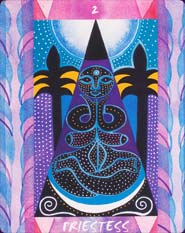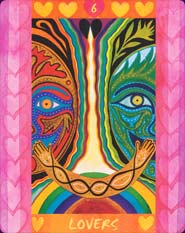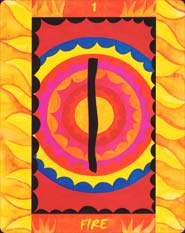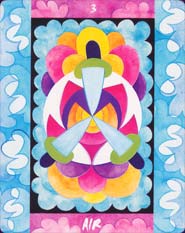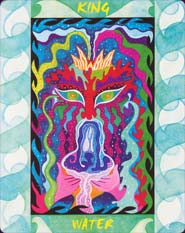Tarot of the Four Elements Deck Review
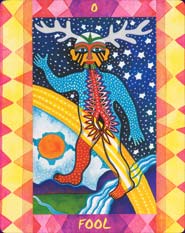
Creators: Isha Lerner, Amy Ericksen
Publisher: Inner Traditions
The Tarot of the Four Elements is new from the creator of the Inner Child Cards and artist Amy Ericksen. These cards are very warm and vibrantly coloured, and use tribal, primal and natural images in their designs.
Retailers
See Price at Amazon.comSee Price at Amazon.co.uk
See Price at Amazon.ca
Tarot of the Four Elements Review by Bonnie Cehovet
Tarot of the Four Elements is definitely a deck where synchronicity plays a large role. The deck itself comes from the mind and soul of artist Amy Ericksen. The ability to understand the vision of what her work could be belongs to Bear & Company. Amy Ericksen knowing herself well enough to know that she could not do justice to the text allowed Isha Lerner to be brought in ... and the rest is history!
In her introduction, Lerner talks about how as humans we communicate through art and imagery. Language, symbol and myth are the tools that we use to bring order to our universe. In spite of our diversity, we are united by the symbols that make up our world. The Tarot itself is ripe with archetypal imagery ... symbols that represent the ancient knowledge of the one tribe that we all are. Lerner goes on to show how the laws of nature are presented to us in the Tarot through the suits (the elements), numbers (sacred geometry) and symbols (images of life).
The Tarot of the Four Elements represents a journey into our elemental nature. Working with the imagery of this deck allows us to connect with nature spirits, elemental energies, and our own imagination, so that we can affect a healing in our own lives. The style of art is primitive, very similar to that of Rachel Pollack in her Shining Tribe deck. The illustrations themselves carry very primal, earth centered energy, with vivid, intense coloring. Certain specific forms, such as spirals and circles, can be seen consistently throughout the deck.
Lerner does a wonderful job of providing background information on symbolism, imagery, archetypes, and sacred geometry. One line stands out for me as truly making a statement about how I see the Tarot: "The Tarot has always been a means to reflect back into consciousness that which is hidden in the collective unconscious of the human experience." 1
Lerner presents background material on the significance of numbers in relation to the Tarot by associating them with archetypal imagery. Rather than one or two keywords, a whole world is opened up by each number. From the book:
"One
It is very clear from a study of the ancient Pythagorean system of wisdom that the essential quality of the number one is not the "quantity" of one, but "quality" of the originating source and power of numbers themselves. This is hard to get our minds around because we are so used to thinking of numbers as quantitative values - one apple, one dollar, one car. The point, the circle, and its circumference (where each place in the circumference is at an equal distance from the center of the circle) are all symbols related to one. All numbers and their geometric correspondences originate from the concept of the point or dot and the circle.
The number one has always been connected on spiritual levels to the idea of unity and wholeness. As explained earlier, it was known to Pythagorus as the monad and considered his chief deity. In astrology, the glyph or symbol used for the sun - the source of all life and light and the center of the solar system - is the circle with a point at the center. The sun is universally associated with the one and monadic vibration.
A little earlier I shared a quotation from Manly P. Hall on which he explained the Pythagorean idea that the body of God was "composed of the substance of light". If this is true, then our sun - the originating source of all light to the Earth and all humanity - is a perfect representation of the power of one in celestial realms and in the material world. From t hat perspective, one of the most important statements revealed in the Old Testament - "Let there be light!" - can be connected not only to the power of one in the world, but to the creator of the universe who exists behind the scenes bringing everything into manifestation.
Eastern and Western esoteric teachings - particularly those associated with Alice A. Bailey and her teacher, the Tibetan master D.K. - refer to the monad as the higher and singular entity to which each human being as a soul-infused personality is attached. This suggests that every human is first and foremost a monad living on a much higher plane of consciousness. This monadic life divides itself into a spiritual triad of will, love and intelligence (a divine trinity), which further subdivides into a human personality dwelling on the four planes known as the mental, astral, etheric, and physical. Thus, one (the source of everything) becomes three (the sacred trinity), which seeks physical manifestation as four (the material world and the elements of fire, air, water and earth).
Many of the mandalas, or Eastern artistic designs utilized in meditation, are composed of circles - often in concentric spheres - that are meant to help the disciple center his or her consciousness. The ancient symbol of the serpent biting its own tail was another representation of the idea of one as wholeness, return to the source, and infinite wisdom. While most interpretations of one are associated with its positive nature as the supreme power originating all of life, a sense of isolation, aloneness and separation comes with it. In modern numerological texts, there will always be a shadow side to every number and primary quality. For one, the negative side shows up as arrogance, willfulness, and an over-emphasis on the self. The higher one vibration should be understood as the compassionate giver of light and life - not the fear-engendering ruler that demands blind obedience and worship."2
In discussing the significance of color, Lerner gives a short synopsis for each of the seven main colors of the human chakra. From the book: "Violet is the nearest color vibration to ultraviolet radiation and the doorway to x-rays, gamma rays and cosmic rays. situated at the top of the color pecking order, so to speak, violet has a strong relation to mysticism, spiritual thoughts, intuitive flashes, and ingenious ideas. Violet is the color of the crown chakra, located at the top of the head, and may help in stimulating the imagination, remembering dreams, and strengthening ESP. Violet can be used to steady the focus in meditation and help one's higher mental concentration. There is a sense of power, authority and majesty associated with violet because it has the shortest wavelength and highest frequency." 3
The deck and book are packaged in a sturdy box that pulls out from one side, with insets for the cards and space for the accompanying book. The cover of the box is a replica of the cover of the book. The cards are 3 1/2" by 4 3/8", of good quality, glossy cardstock. They are not coated, so will need to be handled with care when shuffling.
The backs of the cards are striped with the colors and images of the four elemental suits: Earth (green), Air (blue), Fire (orange-red), and Water (aqua).
The front of the cards carry borders on the right and left hand side, color coded to the elements. At the top of the card we see the card number (or title, in the case of the court cards), with the suit name (or title, in the case of the Major Arcana) across the bottom of the card. In the center, surrounded by a small black border, we see the card illustration.
The Major Arcana are presented with an explanation of the traditional Tarot image, followed by an in depth analysis of Ericksen's representation. Then we have the Elemental Message (what the card is all about - how is functions in a reading), followed by upright keywords. The Minor Arcana and Court Cards have a one page write-up, but no keywords.
This Fool is intended to act as an enchanted spirit guide. He journeys between heaven and earth on a transcending zone of light that holds night and day in perfect balance. The Fool is surrounded by representations of the four elements of nature, and wears a traditional antler headdress, aligning himself with the shaman medicine healer.
The Magician fascinates me - every time I look at it, I see something new! How clever he is, balancing himself on the Moon, while raising his arms to meet the Sun! Now - look at the small female figure in his center. Very cool! He wears a magicians cone shaped cap (looks a lot like a dunce cap to me!), with a star symbolizing constructive freedom. Notice the lightening bolts coming from his hands - the power of manifestation is passing through his being as a clear channel of divine will.
It took some getting used to for me to accept this version of the Priest (Hierophant). He sits cross-legged, as Buddha under the bodhi tree. There are two major designs of power seen on this figure - the labyrinth-like figure in his pelvic region, and a pathway that extends around the heart chakra. The Priest is holding his right hand up, palm out. The branches of the tree above him mirror his hand. The sky behind him is divided into two spaces by the tree - one space shows a starry sky, the other a golden glow, with yellow birds flying about.
I love the dancing figure of Death as we see it here - a skeleton waving a fiery sword in his right hand, while his blue body (with the flame of passion at the center) expresses his true feelings as he strips away worldly attachments. Notice the smile on his face!
The Two of Fire is one of the stronger images in this deck for me. What we see is a blazing fire, being held in check between two vertical lines. One feels as if this is a doorway - that beyond the blazing fire is a whole new world. There is a short, fire-red threshold in front of this fire.
The Ten of Earth brings thoughts of peace to mind. Perhaps that is because I am doing this review right after Christmas, and the outline of this tree reminds me of an Evergreen! Okay - checking the book, it IS meant to bring up thoughts of Christmas! There is a glowing light in the center of this tree, and a lovely yellow pentacle on a red background topping it. Presented here is a simple graphic that immediately brings home the sense of achievement associated with this card.
The court cards are not what one might expect them to be. In the Queen of Fire, we see what appears to be a head, wearing a crown and balancing itself over the spinal column. This Queen is in the process of mastering the healing vibrations represented by the seven chakras. The spinal column appears here in the form of a caduceus (medical staff). For whatever reason, I somehow want to stay with this card, and not put it down!
The one suit that I could not get a handle on with this deck was the suit of Water. Here we see the King of Water, a figure that is very much fantasy. I have to look closely to make him into any sort of form at all, and the multi-colored squiggles (these are meant to be energy forms) in the background do not help. The one thing that is evident is the chalice that he is holding out in front of him.
Lerner gifts us with four Tarot spreads. The first spread (the Essential Self layout) is an interesting one - basically a one card draw. However, after shuffling the cards, they are laid out in a circle. The card drawn is placed in the center of the circle, representing you as the center of your own solar system.
The second spread is a two card spread (the Balancing the Soul layout) - the cards are shuffled, then laid out in a straight line. The first card on the right hand side is drawn, and represents the Seeker's conscious awareness of the situation. The last card on the left hand side is drawn, and represents the Seeker's unconscious needs.
The third spread is a three card spread (the Manifesting Dreams and Visions layout) that takes the form of a triangle. Card 1 (the left hand corner) represents Body, card 2 (the right hand corner) represents Mind, and card 3 (the upper point) represents Spirit. The object of this spread is to bring balance to the Body, Mind and Spirit.
The fourth spread is a four (or five) card spread (the Four Directions layout ). The cards are placed as a cross, with Card 1 (Fire) in the East; Card 2 (Water) in the South; Card 3 (Earth) in the West; and Card 4 (Air) in the North. A fifth card may be drawn, and placed above the spread, as an overview.
This imagery will not be for everyone. If, as Lerner suggests, you go into a reading with your heart open, you will find what you are looking for. I like this deck - it is one that grows on you, and has a great deal to offer!
Tarot of the Four Elements Review by Kate Hill
The Tarot of the Four Elements draws upon tribal and earth-centered symbolism from cultures and religions all over the world: cave paintings, the art of Oceania and the Americas, African art, and human art and its images and symbols. Amy Ericksen’s devotion to Tarot, numerology, art and nature lead her to make these progressive cards of “tribal folklore, earth mythology and human magic” for divination and enjoyment.
The art on each card is a rainbow of chaotic-appearing colours in riotously different, saturated hues. There are a dozen different colours on each card: in geometric patterns in the border, and in the tribal, dotted art of the Tarot scenes. The artist’s style is conceptual, rather than realistic; an idea is represented by the symbols rather than being lifelike representations, which is common in tribal art. Some cards also have an optical effect like the young/old woman picture – the image appears to be one thing, and another when viewed from a different perspective. There is a lot of visual interest in these cards: you can’t look at the card and take in the scene in a single glance.
The major arcana are Tarot-based images and follow standard archetypes, in their fashion, while the minor arcana are associated with everyday magic and very much linked with the four elements. The suits are titled Fire, Air, Earth and Water; numbered from One to Ten and have Page, Knight, Queen and King court cards. These suit cards don’t have scenes as such, but use a blend of colour, form, placement and basic symbols to indicate meaning.
The cards of the Tarot of the Four Elements can be read on two levels: purely from interacting and using your intuition with the images themselves, or with the background structure and information provided by numerology, sacred geometry, tribal art, colour symbolism and Tarot in the companion book. Isha Lerner - who also worked on the Inner Child Cards, Power of Flowers and the Triple Goddess Tarot - worked collaboratively with Amy Ericksen in order to write the companion book and make the product suitable for publication. She worked with Amy long-distance, and produced the book after much consultation and discussion of the card imagery and the artist’s own meanings.
The first two chapters of the companion book provide background on tribal art and symbolism, the philosophy of numbers and Pythagoras’ teachings, and an explanation of numerology as it is used in the cards. Chapter Three gives the basics on Tarot cards and a few spreads to try. Chapter Four explains a traditional Tarot image and its traditional meaning along with the explanation of the Tarot of the Four Elements image -which is more magical and more visionary – followed by the ‘Elemental Message’ which is the unique meaning for the card.
All of the cards’ interpretations, keywords and meanings are empowering and self-transformative; they are positive directives and advice to move forward. Even the Devil’s keywords are: “release rage; shake out the anger; heart power; shout and release; express the male/female balance and true power.” The images and meanings of the minor arcana have been reworked to emphasise the elemental and numerological associations. For example, the Eight of Fire combines the double stability of an eight with fire and action, to mean a sustained activity or effort over a long period, and leading to victory. The Four of Water doubles the feeling of the two and, according to the book, could mean two couples combining their efforts, being fully engaged in an endeavour.
The full set of the Tarot of the Elements has 78 cards and a 198 page book packaged in a good quality laminated cardboard box. I like these sets from Inner Traditions – they may be heavy, but the book paper is good quality and the whole set stands up to the rigours of international postal services very well.
Overall, this is a deeper Tarot than I anticipated at first. It wasn’t until I sat down and really looked through the cards that I grew to have an appreciation for the vibrant, primitive-looking art cards. The images appear to be radically changed from traditional Tarot, but the kernel of the image is true to the Tarot archetype. The radiant cards of the Tarot of the Four Elements are ideal for the reader or beginner seeking a deck for personal transformation and guidance, spiritual development and healing.
Complete Details of Tarot of the Four Elements
Creators: Isha Lerner, Amy EricksenPublisher: Inner Traditions
Deck Type: Tarot Deck
Cards: 78
Rating: 16/20 or
Similar Decks to Tarot of the Four Elements
Creator: Inner Child Cards, Triple Goddess Tarot by Isha Lerner< Previous Deck · Back to Top · Next Deck >
Home > Tarot Reviews > Tarot of the Four Elements Review

